|
|
|
|
|
|
|||||||
| I'm really happy to represent, here and on eBay, the work and treasure of Qubais Reed Ghazala, acclaimed author, designer, and artist. He just has too much stuff and too little room. So he says I can eBay it! This will be fun. | |||||||
|
|
|||||||
|
You may know of Reed through his
electronic work (circuit-bending, now a worldwide art revolution), but
Reed's mediums are many. I've known Reed for a long time, and I've always
thought his other work should be shared. Now it can
be. |
|||||||
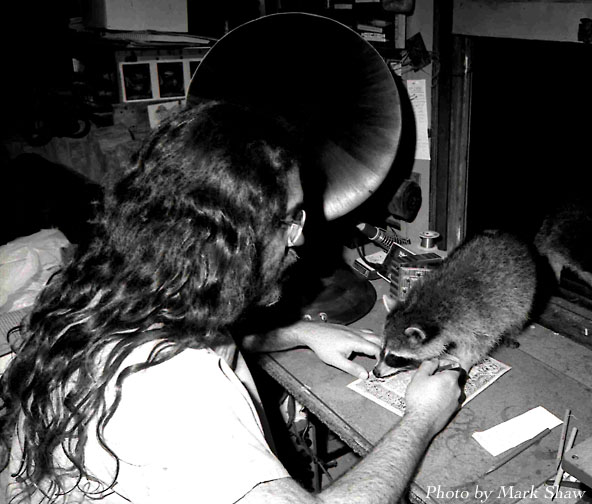 Reed and Whisker Nose in the Anti-Theory Workshop |
|||||||
|
Reed is an "outsider artist," an artist operating outside the tradition. Still independent of academia, Reed has gathered more students and created more artists than any other professional in the electronics field. |
|||||||
"In the domain of modified electronics, Reed Ghazala is the real groundbreaking figure." -Tentacle |
|||||||
|
|
|||||||
"This bloke is the master- and the bloke who started it all." -Electro-music.com |
|||||||
|
What's more, the influence of
Reed's electronics upon practicing artists has now outreached that of John
Cage, David Tudor, Babbitt, Luening, Subotnik, and others. Had Reed been
inside the tradition, he would have been on the cover of TIME by now. Now
that I think of it, one of Reed's raccoons was on the cover of TIME. But a
raccoon will sit anywhere. |
|||||||
|
|
|||||||
|
While you can always find Reed's work in the hands of fellow artists, it also resides in the permanent collections of the Museum of Modern Art, the Guggenheim and the Whitney in New York City and in many private collections around the world. |
|||||||
|
|
|||||||
|
Reed has designed for Tom Waits,
Peter Gabriel, King Crimson, Faust, Keith Richards, the Simon and
Garfunkel band, Blur and many other well-knowns. Reed has been consultant
to Sri Chinmoy, Blue Man Group, Nine Inch Nails, MTV, … oh my, these lists
he gave me just go on and on. |
|||||||
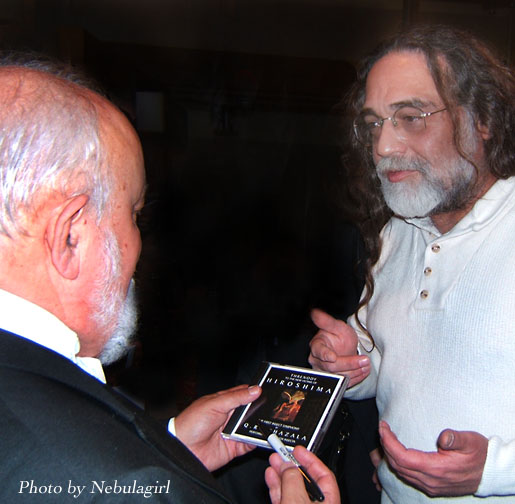 Reed Ghazala and Krzysztof Penderecki |
|||||||
|
Reed's work has been covered in the established press, such as the New York Times, the Washington Post, The Smithsonian, even the Wall Street Journal. |
|||||||
|
|
|||||||
|
|
|||||||
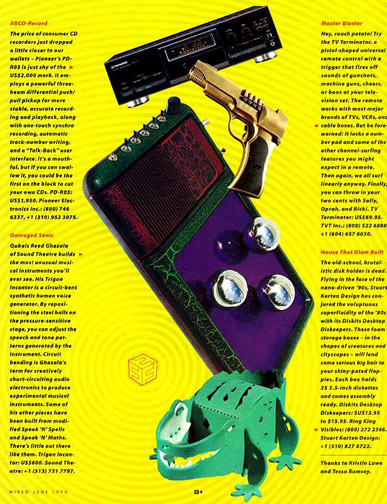 Reed's trigon Incantor in WIRED |
|||||||
|
Reed has authored numerous
articles in various periodicals. This includes the seminal
EMI series, in which Reed's art of circuit-bending was first fully
described. Here Reed outlined the general terms of circuit-bending, as
well as detailing the first Casio SK-1 bending instructions (1996), the
heart of just about any bent SK-1 you see anywhere
… |
|||||||
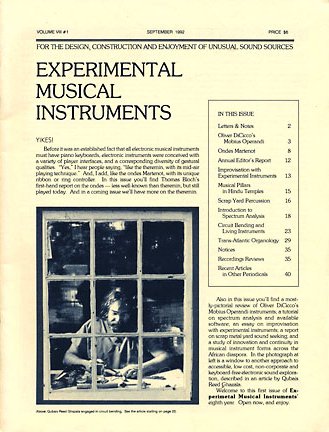 |
|||||||
|
Reed's publications are likewise behind the Incantor, or circuit-bent Speak & Spell series, possibly the most circuit-bent instrument in the world. |
|||||||
"… plenty of brilliant musical instrument inspiration." -Peter Kirn, Createdigitalmusic.com |
|||||||
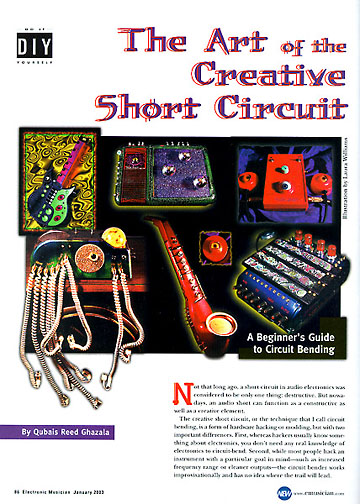 Reed's article in Electronic Musician |
|||||||
|
With the publication of Ghazala's
Circuit-Bending, Build Your Own Alien Instruments (John Wiley & Sons,
2005), the first book on the subject came to be. Watch for signed,
annotated, maybe even Ghazala-cartooned books in my eBay
listings! |
|||||||
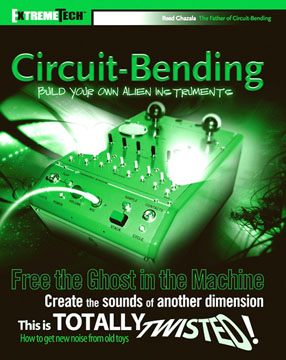 |
|||||||
| Click here for reader's reviews from
Amazon |
|||||||
|
Likewise, it was this site,
anti-theory.com, that first presented the terminology of circuit-bending
online, the first online how-to, and the first online picture gallery of
circuit-bent instruments. |
|||||||
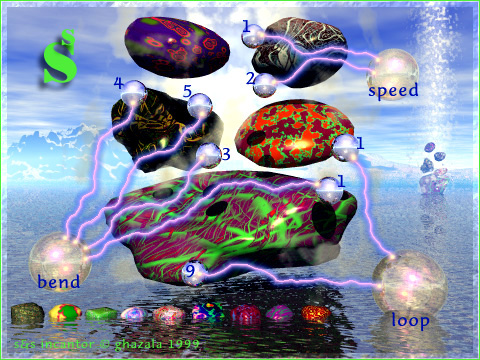 Reed's schematic for bending a Speak & Spell |
|||||||
"… his work is arguably among the most influential of the last few decades." -Suite 101 |
|||||||
|
Ghazala is one of the most
influential artists living today, if not the most. His perspective and
methodology having broken all traditional technological and social
barriers, circuit-bending having become a standard of electronic design
the world over, from street artist to Ivy League. |
|||||||
"Take note: nothing comes close to Q R Ghazala for artistry, for creative instrumentation or intelligent presentation." -Andy Waggoner |
|||||||
|
Ghazala is a true Renaissance man and artist, one of today's few visionaries. His work is insightful, original, and has proven to be wildly valuable, as it has swiftly actualized thousands of artists, more and more every day. |
|||||||
|
|
|||||||
|
|
|||||||
| Through my
eBay listings I'm offering unique items from Reed's instrument workshop,
art studios and collections. (I witnessed some of this stuff falling on
Reed in his workshop and offered to thin his clutter. We don't need any of
his raccoons getting hurt). Some of the items offered will be known to persons familiar with Reed's history. But others will not. Along with artworks and instruments, at auction will also be antiques and various oddities. Here are the categories … |
|||||||
|
Circuit-Bent Instruments |
|||||||
|
|
|||||||
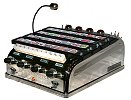 |
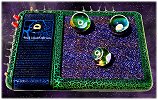 |
 |
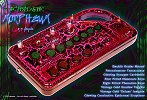 |
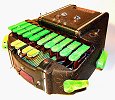 |
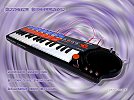 |
||
| Dworkian Register | Gateson Trigon | Fury Incantor | Morpheum | Vox Insecta | Fractal oscillator | ||
As you know, Reed Ghazala founded and named Circuit-Bending, considered to be planet earth's first electronic art movement. This is a great milestone, and only history will reveal the depth of Reed's influence upon technology and music, as well as upon the advancement and understanding of aleatoric art itself. After all, school kids are now learning to build and play chance-based instruments at the same age when, just ten years prior, only the four off-notes of a plastic-fluted "Mary Had a Little Lamb" rattled the music teacher. |
|||||||
|
"Many
of the instruments he's designed and built are among the most interesting
and unusual a person could hope to encounter. Simply stated, Q R Ghazala
is a genius."
|
|||||||
| Reed
witnessed a chance short-circuit of a battery-powered audio amplifier back
in the mid 1960s. Further chance exploration of this circuit, connecting
wires here and there, convinced Reed that there was much more to be
discovered. In Reed's
Leonardo Music Journal article he describes this experience
Ghazala's instruments have evolved incredibly over his 40-year design history. In shape, sound, and appearance, all have been noteworthy. From his tiny spinning speakers of the 1960s to the "plastokenisis" of today, Ghazala's work is always fantastic (some features are even patent-pending). |
|||||||
|
"a
real pioneer"
|
|||||||
| Solway Galleries of New York and Cincinnati, the agents of Nam June Paik, Laurie Anderson, and others, did an appraisal of Reed's work and value finished instruments in thousands of dollars. I will be offering Ghazala's circuit-bent originals with low or no reserve. This will include prototypes as well as known designs. | |||||||
|
"The
culture behind Circuit Bending owes a lot to Reed Ghazala… overall it is a
stand-alone art form unlike any other." |
|||||||
|
Recordings and Historic |
|||||||
|
"... an American original, rivals some of the work by
such masters as Penderecki & Xenakis ... simply incredible."
|
|||||||
| Though very
few, Reed has special edition versions of music packages. One of these is
the Requiem for a Radio, a CD issued with a laminated card containing a
tiny chip of the plastic radio itself, the actual radio heard being
transformed in the recording! |
|||||||
|
|
|||||||
|
"...
continuing in the tradition of such sound pioneers as Karlheinz
Stockhausen and John Cage, Q R Ghazala is blazing new paths as an
experimental composer, musician and instrument designer... these records
(Requiem, Threnody) stand as art ..."
|
|||||||
| BE-IN posters, posters from the EMI writings, original EMI magazines containing Reed's first articles on circuit-bending, and classic stationery from the Sound Theater days (Reed's first music label) are still available for collectors. | |||||||
|
|
|||||||
|
|
|||||||
| Even some
vintage cassettes of There is a Secret Garden (the world's first Incantor
chance music recording, with Reed's hand art inside) might show-up on
eBay! |
|||||||
|
|
|||||||
|
|
|||||||
| Here are
reviews, and a little more
on Reed's recordings as well as Reed's
discography |
|||||||
|
Visual Art: Pigments, Sculpture, Photography |
|||||||
Like Jackson Pollock, Ghazala's work often centers around chance. Though Reed's chance work in electronics is better known (circuit-bending is a chance-based process), his explorations as chance visual artist have covered more time, and are equally innovative. |
|||||||
|
"[Ghazala] is an important contemporary chance artist also
pioneering aleatoric work in visual
media." |
|||||||
| As with circuit-bending, the pioneering of technique and technology can be seen in this visual work. In fact, the web's finest gallery devoted to contemporary aleatoric art names Ghazala … | |||||||
|
"Honorary President of the Aleatoric Art Movement"
|
|||||||
|
Pigments |
|||||||
| Reed has
pioneered chance techniques in both photography-using dye migration,
polarization, as well as lens and camera design-and suminagashi, the
free-form patterning of ink upon water. |
|||||||
|
|
|||||||
| I will be
offering original works of Reed's incredible suminagashi as well as
museum-quality prints of his astounding dye
migrations. |
|||||||
|
Sculpture |
|||||||
| Reed has
shown experimental artworks, in juried competition, from the age of eight
onward. This began as a series of cubist catacombs and towers, all of
clear class, but with a very few panes colored with transparent film. Reed
would position these sculptures according to local sunlight, ensuring that
color projections would combine in the sculpture's shadows. These were followed by a series of "Frank Lloyd Wright" houses, a name that Reed's grade school teachers gave these pieces. They are modeled in glass and sliding cardboard panels that open to change room configurations. Many other constructions involving flight, pyrotechnics, radio control, electro-magnetism, sticky gels and viscosity (What's wrong with this guy?), metal dust in water, and all kinds of things, played into these early projects. |
|||||||
|
"Reed's work constantly surprises on its own terms and has
established Reed as a materials and concepts visionary." |
|||||||
| Today,
Reed's chance sculpture has been on display from Paris to New York and
beyond, looking to lasers, liquids, mists and electrolumia for
materials. |
|||||||
|
|
|||||||
| I will be
offering to a lucky bidder an assortment of Reed's 3-D work, often
chance-based and usually who-knows-what-based, knowing
Reed. |
|||||||
|
Photography |
|||||||
| As a little
boy, Reed's playground was a photographic darkroom. His mother, a
professional photographer, had Reed exposing and developing prints by the
age of five. "I grew up to the odor of Hypo and Dektol" says Reed,
recalling the smelly darkroom chemicals. 2-D and 3-D animations would soon follow, using his mom's 8mm movie cameras (watch for these on DVD in my eBay sales.) Today, Reed's photographic work is published and collected worldwide. Similar to circuit-bending, Reed's original techniques can turn the mundane into something extraordinary. |
|||||||
|
"…
you'll find lots of fantastic and imaginative art and designs
…"
|
|||||||
| Reed's
best-known innovation in lensed photography (as opposed to lens-less-that
is, his dye-migration techniques), is a lens-shift method (focus or
aperture) during cross-axis polarization (two polarizers adjusted to
create a variable "neutral" density filter). This allows for lengthy
daytime time exposures and thus chance light movements are thereby
captured. |
|||||||
|
|
|||||||
| As illustrated, this creates a soft radial mistiness, similar to zoom techniques, but without that hard and familiar "zoomed-out" look. | |||||||
|
"Qubais Reed Ghazala, founder of the circuit-bending
chance-music movement, is an important contemporary chance artist also
pioneering aleatoric work in visual
media."
|
|||||||
| Reed's work
in nature photography is exceptional. He's always in the woods watching
snails or shaking trees to get bugs out to photograph. Okay, so Reed keeps moths in the refrigerator to "slow them down a little for nice poses." And so what if his dezapped bug zapper (with giant silk Luna moth wings and a recording of the Mothra girl's song inside) is covered with moths in the springtime when he hangs it in the woods? So what if he is mad? I would sleep with him. |
|||||||
|
|
|||||||
Reed also modifies cameras, designs lenses and filters, and seeks unusual light sources for his photography. This can be seen in Reed's landscape work as well as still-life and portraiture. I will be offering signed prints of Ghazala's work from his present catalog, and new work as it happens. |
|||||||
|
|
|||||||
|
|
|||||||
|
|
|||||||
|
|
|||||||
Reed has acquired a substantial collection of antiques. Toys, dolls, framed art, sculptures, ceramics, vintage electronics and way more than that. I'll be researching and presenting these as time allows. |
|||||||
|
|
|||||||
|
Parts |
|||||||
Sometimes, to get a certain cool part for a project, Reed has to buy the whole box or shelf in surplus and salvage stores and warehouses. Circuit-benders take note! I will be offering some of Reed's coolest extras from the Anti-Theory Workshop itself! I have Reed's stash! Expect super-cool finishing elements such as vintage switches of unusual styles, shuttered or polarized World War and Cold War glass-and-brass panel lights, knobs that look like musical notes, and all kinds of stuff. |
|||||||
|
|
|||||||
|
Oddities and
Curios |
|||||||
| Well, Reed
collects these. He likes unidentifiable things… |
|||||||
|
|
|||||||
| So, every-so-often, I'll probably have a mystery item for you to guess about, since he can't stop collecting this stuff, and we'll both get a kick out of offering it online. Or, as said, just weird stuff (we started this whole thing off with the auction of a dog footprint in shiraz and cornstarch, the first dog footprint to sell on eBay). | |||||||
|
"He is
totally crazy." |
|||||||
|
|
|||||||
All the items I sell on eBay will come with a card stating what the item is (as best I can figure), and the origin being the Q. R. Ghazala Estate. If you've attended real auctions or road shows, you know that items with history are more valuable than items without. Much of what Reed has has a weird history. So, when you log on to eBay, just do a Ghazala keyword search to see if anything's up. I'll have "Ghazala" in each auction title, whether antique, artwork, or bent instrument. Have fun, and good luck bidding on some of the most interesting and valuable art of Reed's world! |
|||||||
|
|
|||||||
See you on
eBay, Take me to Ghazala on eBay > Click here to see my auctions |
|||||||
|
|
|||||||